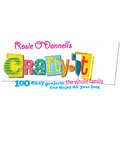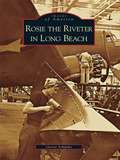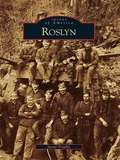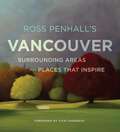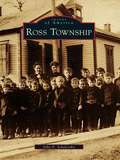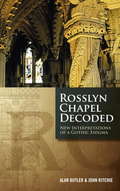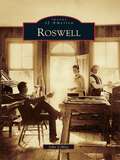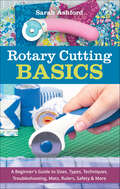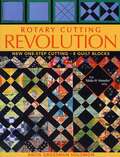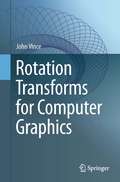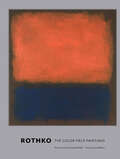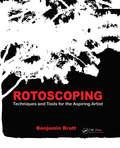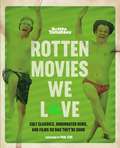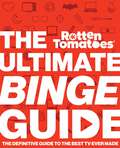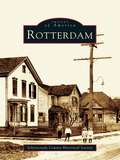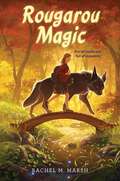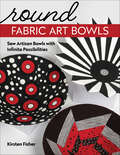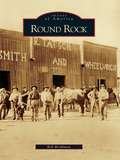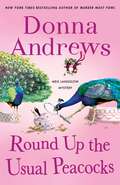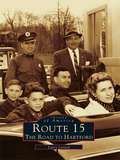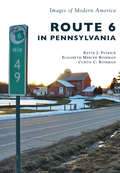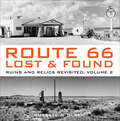- Table View
- List View
Rosie O'Donnell's Crafty U
by Rosie O'DonnellBring out the craft supplies and roll up your sleeves! Rosie O'Donnell's Crafty U will give "U" all the help you need to entertain your kids throughout the year. From television personality, children's advocate, and veteran crafter Rosie O'Donnell comes a fresh and fun collection of 100 easy craft projects for parents and kids (age 5 through 12). Projects include bunny piñatas for spring, tie-dye T-shirts for summer, creepy costumes for Halloween, very merry garlands for the holidays, Valentine's Day bouquets, and much more. Packed with practical advice, step-by-step instructions, and gorgeous full-color illustrations, Rosie O'Donnell's Crafty U offers plenty of inspiration for craft projects the whole family can enjoy on holidays, rainy days, or any "crafty" day!
Rosie the Riveter in Long Beach (Images of America)
by Gerrie SchipskeDuring World War II, an unprecedented number of womentook jobs at aircraft plants, shipyards, munitions factories, and other concerns across the nation to produce material essential to winning the war. Affectionately and collectively called "Rosie the Riveter" after a popular 1943 song, thousands of these women came to the U.S. Army-financed Douglas Aircraft Plant in Long Beach, the largest wartime plane manufacturer, to help produce an astonishing number of the aircraft used in the war. They riveted,welded, assembled, and installed, doing man-sized jobs, making attack bombers, other war birds, and cargo transports. They trained at Long Beach City Schools and worked 8- and 10-hour shifts in a windowless, bomb-proof plant. Their children attended Long Beach Day Nursery, and their households ran on rations and victory gardens. When the men came home after the war ended, most of these resilient women lost their jobs.
Roslindale (Then and Now)
by Anthony Mitchell SammarcoOnce referred to as the "Suburb Superb," Roslindale was at one time part of the town of West Roxbury, which had been set off from Roxbury in 1851. The rapid development of Roslindale, which was annexed to the city of Boston in 1874 and was then known as the South Street District, was largely due to the Boston and Providence Railroad and the streetcars that connected the area to Forest Hills Station. By the twentieth century, Roslindale had developed as a distinctive neighborhood that attracted residents of all walks of life, with dells and valleys reminiscent of Roslin, Scotland, from which it received its name. Roslindale chronicles the growth of this neighborhood from the birth of photography through today by combining vintage images with modern photographs of Roslindale Square, Washington Street, and noteworthy buildings and businesses.
Roslyn
by Jaymi TrimbleRoslyn, a mining town nestled in Washington's Cascade Mountains, is a little town with a big history. Founded three years before Washington was admitted to the Union, Roslyn became a boomtown after the discovery of coal. Coal was king in Roslyn for 80 years, and immigrants came from all over the world to work the mines. Roslyn's remarkable history includes stories of murder, a mine strike that ended with the mine boss tied to the railroad tracks, and a bank robbery some claim was masterminded by Butch Cassidy and the Sundance Kid. Readers will meet characters like Tony Bailey--he turned out to be a she--who worked the mines for 11 months in 1949 before being arrested one night in a tavern for going into the women's bathroom dressed as a man. And no book about Roslyn would be complete without a chapter on the hit television series Northern Exposure, which was filmed there.
Ross Penhall's Vancouver, Surrounding Areas and Places That Inspire
by Ross PenhallA collection of 120 paintings by renowned artist Ross Penhall that celebrates the identity and spirit of Vancouver. Also included are paintings of inspirational places across Canada, the US and Europe, including the California Coast, the Prairies and the Italian countryside. Ross Penhall's Vancouver combines stunning imagery, tribute and personal history to create a portrait of the city through an artist's eyes. Ross Penhall was born and raised in Vancouver, where he has had two separate and successful careers as a fire captain and now as an internationally recognized painter. Visitors and residents alike will look at Vancouver in a new way after they see it from Ross' unique perspective. Whether it's a row of hedges on the corner of someone's yard or the cascading rocks at Spanish Banks, Ross finds endless inspiration in the city where he lives. In addition to paintings of Vancouver, there is a chapter on Surrounding Areas that focuses on the scenery of the Interior, Vancouver Island and Coastal British Columbia. The final chapter, Places That Inspire, includes paintings of the Pacific Northwest of the United States, the Canadian Prairies and landscapes from Ross' travels abroad. For lovers of art, for lovers of Vancouver and for anyone who looks for beauty in the everyday world, Ross Penhall'sVancouver is a book that will continue to captivate readers long after they first open it.
Ross Township
by John D. SchalcoskyOn June 26, 1809, John McKnight and 30 other residents of Pine Township petitioned the courts of Allegheny for the formation of a new township. In the November term, permission was granted, and Ross Township was born. However, the story does not begin there. In the 17th and 18th centuries, Ross Township was settled by early Native American warriors and hunters who used the land as a hunting ground. Ross Township includes the tales of Casper Reel and his family, the first white settlers "North of the Allegheny;" Simon Girty, traitor and renegade of the Revolutionary War; and the infamous Biddle Boys' escape from prison with the warden's wife and escapade through Perrysville in the winter of 1902.
Rosslyn Chapel Decoded: New Interpretations of a Gothic Enigma
by John Ritchie Alan ButlerRosslyn Chapel is a deeply enigmatic 15th-century Gothic masterpiece, situated near Edinburgh. Although generally referred to as a 'chapel' and acting as a local parish church these days, Rosslyn is actually much more than either - and in fact most people who have studied the site in detail come to the conclusion that those who created the structure in the 15th century were not, in reality, intent on building a Christian church at all. In fact, nothing at Rosslyn is what it seems. With its overpowering air of mystery, its superlative stone carvings and its strong Templar and Freemasonic connections, Rosslyn represents one of the most absorbing historical puzzles in Britain. The discovery of new evidence by the authors puts a new slant on the motivations of those who decided to create a New Jerusalem in the Scottish Lowlands. The signs pointed the authors to a lost holy relic - the skull of St Matthew the Evangelist, in whose name the chapel is dedicated. There is startling evidence that this skull came to Rosslyn in the early 15th century, brought there by polymath, librarian and all-round genius Sir Gilbert Hay, who also put together a substantial library.What follows is no less than an adventure, using the clues from the lost books to locate St Matthew's skull - now in Washington, DC. The authors also embark on a thorough examination of Rosslyn Chapel's credentials, both a Christian church and as an icon of the impending Renaissance, a reconstruction of King Solomon's Temple and an astronomical observatory - all suffused with ancient beliefs that would have had the chapel's builders burned at the stake if their true motivations had been discovered.
Roswell
by John LemayBest known as the site of an alleged flying saucer crash in 1947 and the "Roswell Incident," Roswell began as a humble trading post in the late 1860s along the Goodnight-Loving Cattle Trail and eventually grew into a metropolis of southeastern New Mexico. Once a cow town and home to famous Western figures such as John Chisum, Pat Garrett, and Capt. Joseph C. Lea, Roswell is also the birthplace of the New Mexico Military Institute, the testing grounds for Robert H. Goddard's rockets in the 1930s, and the site of the Roswell Army Airfield and a German POW camp in the 1940s. Today Roswell is a popular tourist destination and home to more than 50,000 residents.
Rotary Cutting Basics: A Beginner's Guide to Sizes, Types, Techniques, Troubleshooting, Mats, Rulers, Safety & More
by Sarah AshfordRotary cutting confidence is possible with this beginner-friendly reference book! Tips on how to choose the right cutter for the job, use a cutter safely, and beginner and advanced techniques you can accomplish with any rotary cutter. Plus, learn what other tools you might need along the way, equipment care and troubleshooting tips. Quilters and sewists can now demystify rotary cutting and select the right tool for the job to help them achieve efficiency and accuracy. Get the perfect cut every time!
Rotary Cutting Revolution: New One-Step Cutting
by Anita Grossman SolomonWith these eight quilt block designs, learn a fabric-cutting technique that will save you time and money.The Make It Simpler® Way of rotary cutting is a brand-new method for cutting your fabric pieces quickly-in just one step! Bestselling author and teacher Anita Grossman Solomon shows you how to cut squares into smaller pieces with precision but without waste. When you use her efficient shortcuts, you’ll get more bang for your fabric buck!• Build your blocks the Make It Simpler® Way-stack, cut, and sew perfect blocks • Revolutionary cutting technique saves time without wasting fabric• Over 300 photographs guide you every step of the way• Streamline eight traditional blocks including Pineapple, Old Italian, and Windmill • Learn how to pre-sew the “Anita’s Arrowhead” block prior to cutting• Unique sewing and construction tips
Rotation Transforms for Computer Graphics
by John VinceRotation transforms are used everywhere in computer graphics from rotating pictures in editing software, to providing an arbitrary view of a 3D virtual environment. Although the former is a trivial operation, the latter can be a challenging task. Rotation Transforms for Computer Graphics covers a wide range of mathematical techniques used for rotating points and frames of reference in the plane and 3D space. It includes many worked examples and over 100 illustrations that make it essential reading for students, academics, researchers and professional practitioners. The book includes introductory chapters on complex numbers, matrices, quaternions and geometric algebra, and further chapters on how these techniques are employed in 2D and 3D computer graphics. In particular, matrix and bivector transforms are developed and evaluated to rotate points in a fixed frame of reference, and vice versa.
Rothko: The Color Field Paintings
by Janet Bishop“Sumptuously illustrated with reproductions of 50 paintings, this book celebrates the rich artistic legacy of American artist Mark Rothko” (Publishers Weekly).Mark Rothko’s iconic paintings are some of the most profound works of twentieth-century Abstract Expressionism. This collection presents fifty large-scale artworks from the American master’s color field period (1949–1970) alongside essays by Rothko’s son, Christopher Rothko, and San Francisco Museum of Modern Art curator of painting and sculpture, Janet Bishop. Featuring illuminating details about Rothko’s life, influences, and legacy, and brimming with the emotional power and expressive color of his groundbreaking canvases, this essential volume brings the renowned artist’s luminous work to light for both longtime Rothko fans and those discovering his work for the first time.
Rotoscoping: Techniques And Tools For The Aspiring Artist
by Benjamin BrattMaster what it takes to make your rotoscoping and digital painting blend seamlessly into each shot. Through illustrious four color presentation, the book features step-by-step instruction on the artistic techniques of rotoscoping and digital painting with lessons on:*Articulate mattes*Digital paint in moving footage*Motion tracking*Advanced rotoscoping and digital paint techniques, and much moreIt also features practical insight on the subject and industry, delving into:*The history and evolution of rotoscoping and the role of the rotoscoper*A typical day in the life of a rotoscoper*How to get a job as a rotoscoper
Rotten Movies We Love: Cult Classics, Underrated Gems, and Films So Bad They're Good
by The Editors Rotten TomatoesHook. Wet Hot American Summer. Valley of the Dolls. There are some movies that defy traditional critical assessment -- films that are panned by reviewers, but that go on to become beloved classics and cult phenoms anyway. Ever been crushed to learn your favorite movie -- or a new one you're dying to see -- has been given the big green splat from Rotten Tomatoes' infamous Tomatometer? The site's editors stand by their critics and scores, but they also feel your pain: Fresh films shouldn't get all the glory! In Rotten Movies We Love, the RT team celebrates 101 Rotten movies that can't be missed, including:Box office behemoths that bombed with critics: Space Jam, Maleficent, Bad BoysSci-fi treasures so bad they're awesome: Cherry 2000, Zardoz, Masters of the UniverseRare Rottens from Fresh directors: The Life Aquatic with Steve Zissou, Marie Antoinette, Legend, WillowDeeply beloved cult classics: The Last Dragon, Empire Records, The Craft, MacGruber Underrated gems ahead of their time: The Strangers, Event Horizon, Practical Magic, The Cable GuySequels worth a second look: Home Alone 2, Rocky IV, Jurassic Park III, Return to OzFeaturing 16 essays from some of the world's most well-known film critics -- Leonard Maltin, Terri White, Amy Nicholson, David Fear, K. Austin Collins, and more -- and punctuated with black-and-white film stills and punchy graphics, it's a fun romp through the quirkier corners of film history, sure to delight any cinephile or pop-culture fanatic.
Rotten Tomatoes: 296 Must-See Shows That Changed the Way We Watch TV
by Editors of Rotten TomatoesIn Rotten Tomatoes' first TV-focused book, discover the best shows ever made.For the completist, The Ultimate Binge Guide is a challenge: a bingeable bucket list of all the shows you need to see before you die (or just to be super-informed at your next dinner party). For all readers, it's a fascinating look at the evolution of TV.The guide is broken down into several sections that speak to each series' place in TV history, including:Classics That Made the Molds (And Those That Broke Them): The Jeffersons, All in the Family, Sanford and Son, The Mary Tyler Moore Show, Get Smart, Cheers, Golden Girls, Happy Days...Tony, Walt, Don, and the Antiheroes We Loved and Hated: Oz, Mad Men, The Sopranos, Breaking Bad, The Americans, Peaky Blinders, Ozark, The Shield, Boardwalk Empire, How To Get Away With Murder...Game-Changing Sitcoms and the Kings and Queens of Cringe: Insecure, Community, 30 Rock, Curb Your Enthusiasm, Fleabag, Black-ish, Party Down, Veep, Catastrophe, Fresh Off the Boat, Tim and Eric, Schitt's Creek, Better Things, It's Always Sunny In Philadelphia, Pen15, Freaks and Geeks, Broad City, Black Lady Sketch Show...Grown-Up Genre: Buffy The Vampire Slayer, The X-Files, Battlestar Galactica, The Expanse, Supernatural, The Walking Dead, American Horror Story, Star Trek, Watchmen, The Witcher, Stranger Things, Game of Thrones, Westworld, Doctor Who...Mysteries and Mindf--ks: Twin Peaks, Lost, Sense8, Mr. Robot, Broadchurch, The Leftovers, Fargo, Top of the Lake, Killing Eve, Wilfred, True Detective, Hannibal, Mindhunter...Reality TV and Docuseries That Captured the Zeitgeist: The Last Dance, Making A Murderer, Cheer, Tiger King, Planet Earth, RuPaul's Drag Race, Wild Wild Country, Queer Eye, The Jinx, Anthony Bourdain: Parts Unknown...In this punchy full-color guide, the editors of Rotten Tomatoes complement series write-ups with engaging infographics; fun sidebars (like a battle between the US and UK editions of The Office); and deep-dive essays on the streaming wars, superproducers to know, and the evolution of our collective viewing habits.
Rotterdam
by Schenectady County Historical SocietyNestled among the rolling hills of the Mohawk Valley, the town of Rotterdam was formed in 1820 from the Third Ward of the city of Schenectady. Its history, chronicled in Rotterdam's two hundred images, begins much earlier and is essentially the story of people past and present. The original settlers, mostly of Dutch origin, turned the wilderness into farmland. Their descendants and those who followed expanded into other livelihoods, producing goods that were shipped first along the Erie Canal and later across the nation by rail.
Rougarou Magic
by Rachel M. MarshAfter discovering that the creatures from Cajun folklore actually exist, Feliciana is torn between hiding her Southern heritage and starting fresh at her new school—all while caring for an unexpected magical friend. Rachel M. Marsh’s debut novel is for fans of Tracey Baptiste’s The Jumbies and Katherine Applegate’s Crenshaw.Twelve-year-old Feliciana Fruge does not like Boston. If given the chance, she would gladly move herself and her mom from the freezing city right back to Grandma’s house in Louisiana. Feliciana dreams of escaping her stepfather’s corny jokes and bland food and the relentless bullying at school for “being poor” and having a Southern accent.So, when she transfers to a new school and has the chance to start fresh, Feliciana plans to be as un-Cajun as possible in order to blend in. But then Grandma sends Feliciana a mischievous and magical monster from Cajun folklore—Roux the rougarou. While Grandma might have meant for rambunctious Roux to keep Feliciana company, now Feliciana must juggle making new friends, outsmarting a bully, creating her best art to qualify for an upcoming competition—and hiding her mysterious, magical canine companion from everyone.Rougarou Magic is a magic-laced, tenderly drawn love letter to Cajun folklore, the bittersweetness of starting over when you least expect it, and the unlikely friends you make along the way. Rachel M. Marsh’s debut novel explores themes of friendship, family, self-identity, and change and will captivate animal lovers and fans of Ghost Squad.
Round Buildings, Square Buildings, and Buildings that Wiggle Like a Fish
by Philip M. IsaacsonA fascinating introduction to architecture takes readers on a tour of buildings the world over, from the Taj Mahal to New York's TWA Terminal, and discusses the main elements that give buildings their character.
Round Fabric Art Bowls: Sew Artisan Bowls with Infinite Possibilities
by Kirsten FisherCraft fabric bowls with ease Perfect for display or gift-giving, modern, functional artisan fabric bowls are deceptively simple to make. The artisan fabric bowl projects are a few common tools and a (reusable) template away — you won't want to stop at just one! While you can whip up the projects on your sewing machine for a fast, easy home decor project, you can also enjoy the tranquility of hand-sewing artisan bowls. In Round Fabric Art Bowls, you'll learn everything you need to know to construct fabric bowls, from adjusting the bowl size to choosing fabrics. Six 18" bowl projects feature machine sewing and piecing, modified paper piecing, applique, hand sewing, English Paper Piecing, and more for eye-catching results Apply common quilting techniques, decorative sewing, and fabric manipulation to elevate your fabric art bowls Making fabric bowls is addictive and deceptively simple, and alongside Kirsten Fisher’s previous book, Modern Fabric Art Bowls, you can create a stunning gallery of bowls to display and gift
Round Rock
by Bob BrinkmanNamed for a distinctive rock formation that marks a natural, picturesque ford, Round Rock is a reflection of the past. Nomadic people lived here for countless ages, leaving clues of their existence for future generations. Explorers and frontier travelers visited the area bounded by rolling hills to the west and fertile fields to the east. The location became a permanent name on the map when settlers made the site their home in 1851. These pioneers established the traditions that defined the community. Positioned near the state capital, Round Rock has prospered through transportation and commerce. Horseback paths, stagecoach routes, military roads, and cattle trails have yielded to railroads and highways. Within a few generations, the community once known for education and agriculture is now equally renowned for technology and trade. A common thread through it all has been the citizens' pride of place in their hometown. This is the story of a once-quiet village that evolved into a vibrant city.
Round Up the Usual Peacocks: A Meg Langslow Mystery (Meg Langslow Mysteries #31)
by Donna AndrewsNew York Times bestselling author Donna Andrews first introduced us to Meg Langslow as a crime-solving bridesmaid. In her 31st mystery, Round Up the Usual Peacocks, Meg returns to her roots, juggling cold cases and wedding guests.Kevin, Meg's cyber-savvy nephew who lives in the basement, comes to her with a problem. He's become involved as the techie for a true-crime podcast, one that focuses on Virginia cold cases and unsolved crimes. And he thinks their podcast has hit a nerve with someone . . . one of the podcast team has had a brush with death that Kevin thinks was an attempted murder, not an accident.Kevin rather sheepishly asks for Meg's help in checking out the people involved in a couple of the cases. "Given your ability to find out stuff online, why do you need MY help?" she asks. "Um . . . because I've already done everything I can online. This'll take going around and TALKING to people," he exclaims, with visible horror. "In person!" Not his thing. And no, it can't wait until after the wedding, because he's afraid whoever's after them might take advantage of the chaos of the wedding at Trinity or the reception at Meg and Michael's house to strike again.So on top of everything she's doing to round up vendors and supplies and take care of demanding out-of-town guests, Meg must hunt down the surviving suspects from three relatively local cold cases so she can figure out if they have it in for the podcasters. Could there be a connection to a musician on the brink of stardom who disappeared two decades ago and hasn't been seen since?
Route 15: The Road to Hartford
by Larry LarnedHartford is an old New England river city separated from its eastern neighbors by the Connecticut River. With the opening of the Merritt Parkway in 1940 and construction of the Wilbur Cross Parkway inviting traffic from Boston and New York, the Connecticut legislature realized a new river bridge at Hartford would be a must for local and through traffic. This became a reality in 1942, when the Charter Oak Bridge was opened to traffic. By 1948, the system of roads and highways numbered Route 15 was completed, with Hartford as its focal point. The character of the three Connecticut parkways, the Berlin Turnpike, the Hartford Bypass, and the Charter Oak Bridge is described in Route 15: The Road to Hartford.Highway historian and retired highway engineer Larry Larned, author of Traveling the Merritt Parkway, has appeared in television and radio interviews speaking about Route 15 and the nation's early roads. Route 15: The Road to Hartford presents images from his forty years of collecting and documenting Connecticut roadside culture, architecture, and engineering. His detailed account of the road to Hartford includes personal recollections of traveling Route 15 as a youngster and studying the details along the way-the tollbooths, the bow-tied gas station attendants, the families on picnics at rest stops.
Route 6 in Pennsylvania (Images of Modern America)
by Curtis C. Roseman Elizabeth Mercer Roseman Kevin J. PatrickPennsylvania’s mid-20th-century Route 6 brought together appealing natural environments, historical events, and cultural landscapes. The eastern length of the route crosses an area featuring rolling mountains and tranquil valleys dotted by farms and towns. To the west, Route 6 traverses a more level landscape that also includes lakes. This book presents the 370-mile scenic drive as a destination in itself. It covers the secluded setting of northern Pennsylvania where Route 6 and its towns have experienced minimal changes associated with larger metropolitan regions and interstate highways. As a result, the mid-20th-century landscapes of Route 6 have lingered a little longer. The authors give the reader a peek of a past not entirely swept away.
Route 66 St. Louis Style (Images of America)
by Joseph R. SondermanFor Route 66 to become the most famous highway in history, it had to pass through the "Gateway to the West." St. Louis is the largest city between Chicago and Los Angeles, and "St. Louee" comes first on the list of those that Nat King Cole and many other artists sang out on "(Get Your Kicks) on Route 66." The highway took a maze of different routes, including crossing the greatest of rivers on a bridge with a bend right in the middle. The roadside was lined with flashing neon, classic diners and gas stations where attendants provided speedy service. Also, there were classic amusement parks, drive-in theaters, a man selling frozen custard from a building adorned with wooden icicles, and a motel with a racy but beloved reputation. Joe Sonderman is a St. Louis area radio personality and traffic reporter who has been writing books on Route 66 for 15 years. Since that first work, he has been collecting Route 66 postcards and photographs, some never published before, along with new research on the paths Route 66 took through the area to come up with an entirely new look at Route 66 St. Louis Style .
Route 66, Lost & Found: Ruins and Relics Revisited, Volume 2
by Russell A. Olsen“[The] text and photos make this . . . more than a pretty coffee-table book, Route 66 aficionados will want to add this descriptive tome to their collections.” —Ruidoso News (New Mexico)Much more than a ribbon of crumbling asphalt, Route 66 is a cultural icon revered the world over for its nostalgic value—an east-west artery pointing America toward all the promise that the great West represented. But as stretches of Steinbeck’s “Mother Road” were bypassed and fell into disuse, so too did most of the bustling establishments that had sprouted up from Illinois to California to cater to weary travelers and hopeful vacationers alike. Motor courts, cafes, main streets, filling stations, and greasy spoons—all are represented in this second volume of Lost & Found images from photographer Russell Olsen. As with its predecessor, Route 66 Lost & Found (2004), this new installment presents dozens of locations along Route 66’s entire 2,297 miles, showing them both as in their heydays in period photographs and postcards and as they appear today. Each site is accompanied by a capsule history tracing the locale’s rise and fall (and sometimes rebirth), as well as an exclusive map pointing out its location along Route 66.“Author Russell Olson has unearthed old photos and postcards of various buildings, landmarks and towns which he carefully researches and then rediscovers and takes pictures of them as they are today.” —Auto Aficionado “I could barely put this down.” —Daily Express (UK) “A good read for fans of roadside architecture.” —Classic and Sports Car (UK)
